
The year was 2014, and Doug Tuthill remembers taking a call from a top state lawmaker just after the Florida legislature had authorized its first education savings accounts—the type of state-funded school-choice program that is now fast rising to prominence around the country.
“The speaker called and said, ‘You have two months to implement it, and unfortunately, we didn’t allocate any administrative funding,’” recalled Tuthill, who since 2008 has been president of Step Up for Students, Florida’s leading private-school-scholarship organization. “That was my first experience of thinking about, okay, how do I do this?”
Tuthill wondered the same thing again in April of this year. That’s when Governor Ron DeSantis signed an overhaul of Florida’s complicated school-choice landscape to place a greater emphasis on education savings accounts, or ESAs.
By restructuring programs and lifting eligibility limits, the new law shifted the state’s choice priorities. Instead of mainly providing lower-income families and children with disabilities with private-school scholarships, the new system offers universal eligibility for the more expansive and parent-driven ESA option.
With the state relying mainly on the nonprofit Step Up for Students to run its school choice programs, Tuthill immediately began bracing for the number of Florida students with ESAs to rocket from some 70,000 during the 2022–23 academic year to five times that number just a few months later.
“What I’m looking at now is how to scale,” Tuthill said. “The most interesting part of the ESA discussion really isn’t being talked about, which is putting in place the infrastructure to be able to scale these things up.”
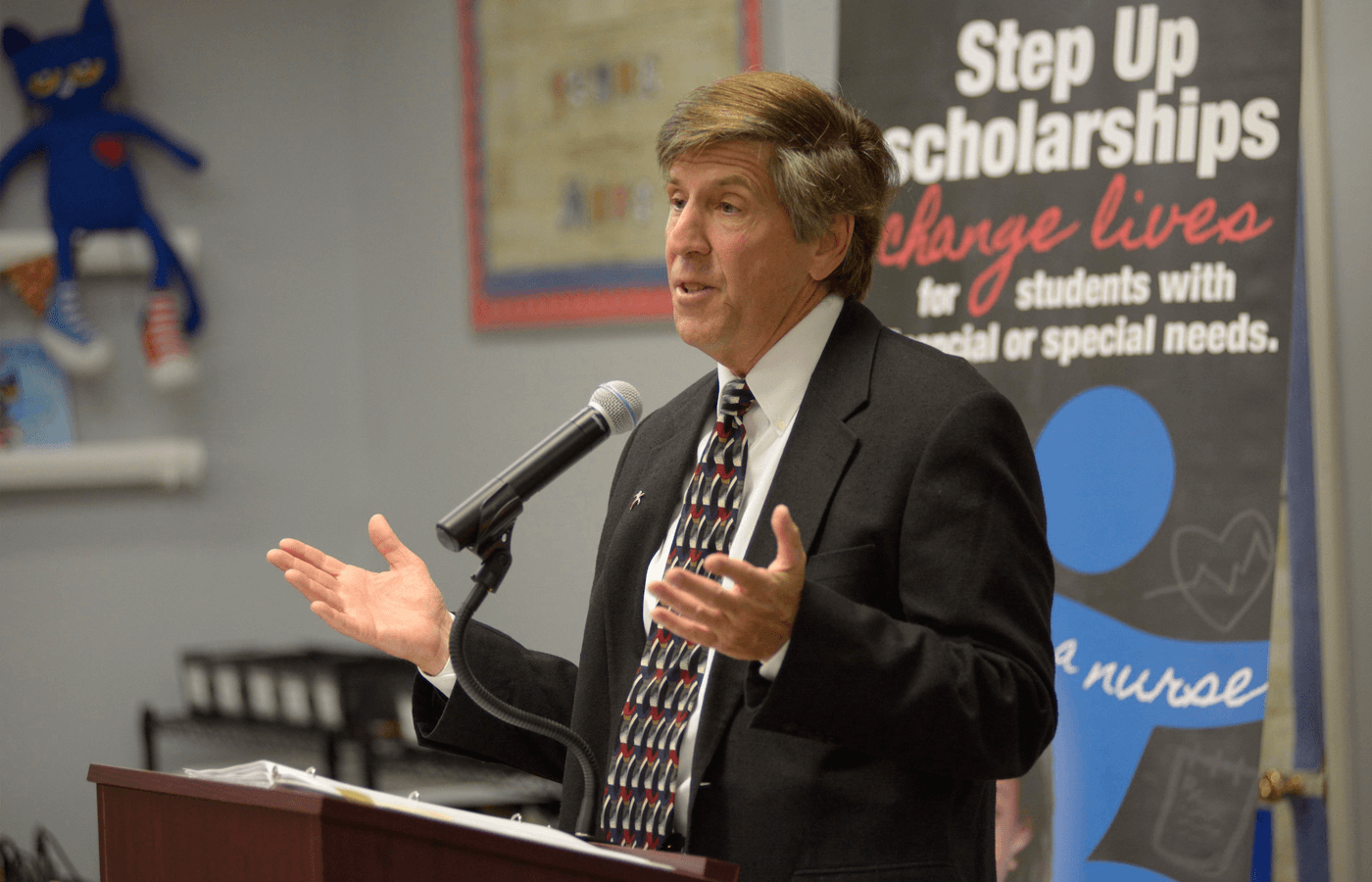
Implementation Woes
In his quest to construct a large, workable, and accountable ESA program quickly, Tuthill has plenty of company. As growing numbers of states, mostly Republican-led, embrace ESAs to support private schooling and parent choice, program managers around the country face similarly complex challenges.
Like Florida, the states of Arkansas, Iowa, and Utah have all enacted laws this year that would open ESAs—sometimes after a multiyear phase-in—to most if not all school-age children in their states. Those four followed Arizona and West Virginia, which started implementing similar universal programs in 2022.
That wave plus other legislative action in 2023 brought to 13 the number of states with one or more education savings account programs funded directly from state revenues. In addition, Missouri has an operating ESA program paid for through tax credits.
Amid this growth, controversies have flared over ESA implementation—most notably but not exclusively in Arizona.
Whether states jumping on the ESA bandwagon are prepared for the challenges that await them remains unclear. Lawmakers sometimes underestimate the practical obstacles to launching and growing ESA programs.
For example, the tension between ease of use for families and accountability for the governance of taxpayer funds resists simple solutions. The problem of defining—and policing—questionable expenses by families may spark both administrative confusion and contentious political debate. And scaling up programs that were manageable when smaller poses a major challenge—not only for administrators, but also for the public they serve.
In a bid to help states navigate this territory, the advocacy organization ExcelinEd has produced a detailed ESA implementation guide and convened a national network of ESA administrators to share best practices and lessons learned.
“I don’t think anyone administratively or on the vendor side has completely mastered this yet,” said Ben DeGrow, who supervises the network as a school-choice policy director at ExcelinEd. “It’s exciting to see more people getting into this space because we’re learning from each other. But we’re still on the learning curve.”
Managing Program Complexity
As ESA programs spread and expand, no state’s program looks exactly like another—and each may look different than it did the year before. Even programs that seem similar on the surface are more complex and distinctive than they appear to policymakers or the public.
“The reality is that each of these programs is unique” because “every state has its own laws,” said Joseph Connor, the founder and CEO of Odyssey, a company created to administer ESAs and education “microgrant” programs. “Every state has its own set of parents and vendors who are going to want their own thing. It’s one of the most complex programs that a state can run.”
Rather than simply subsidizing the cost of sending children to private schools—as vouchers and tax-credit scholarships tend to do—ESAs are typically structured to give families greater latitude in spending the state money deposited into their accounts.
Details on allowable education expenses vary. ESAs usually let families not only pay for private school but also purchase an array of other products and services: curriculum materials, tutoring, textbooks, therapy, enrichment classes, sports equipment, school supplies, and more.
This flexibility makes the program attractive to homeschoolers, but it can be hard for administrators to draw clear-cut boundaries between genuine education expenses and recreational or general family use.
Officials who implement ESA programs face multiple responsibilities, such as marketing to parents, determining their eligibility, and orienting them to the program. Other crucial duties include defining and communicating what qualifies as allowable expenses, developing systems for disbursing funds, and supplying technical assistance to families and service providers.
Building processes that attend to these details and stand up to scrutiny—without unduly burdening users—is a challenge that can make or break a program.
“There’s a lot of moving parts,” said Robert Enlow, the president of EdChoice, a research organization that tracks and advocates for ESAs and other K–12 options beyond district-run public schools. “It’s exciting, and there’s a lot of opportunity, but it’s a lot of hard work.”
Striking a Balance
A common tension in states with ESA programs is the trade-off between convenience for parents on the one hand and accountability for public tax dollars on the other. Advocates say states can strike the right balance, with some supporters arguing that states should err on the side of flexibility.
“The underlying theory is we have to trust families and parents to make those decisions and try not to bring down the hand of government until and unless there’s obvious evidence of fraud,” said Garrett Ballengee, the executive director of the Cardinal Institute for West Virginia Policy, a think tank that champions that state’s ESA program. “And I think that’s probably the right approach to it. Going too far on the rules and regulations side kind of corrupts the original intent.”
In states with ESA programs, officials may not be required to collect, categorize, and report on how exactly families are using their dollars. “We don’t report out as a matter of course on how much people spend on tutoring versus technology, for instance,” said Kathryn Marker, who runs the division of the North Carolina State Education Assistance Authority that administers that state’s ESA program. “We’re not required to report that.”
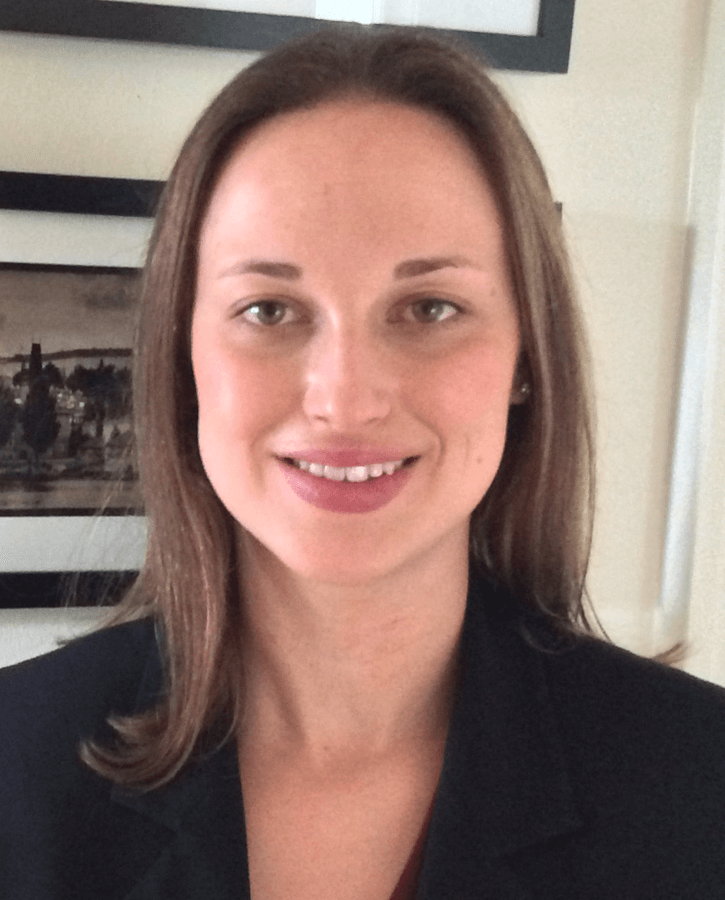
For those who oppose ESAs, the lack of such reporting requirements counts among the many strikes against the accounts. “There are no regulations or set of requirements or guardrails that can make these programs a good idea or a good public policy,” said Jessica Levin, the director of Public Funds Public Schools, an advocacy campaign affiliated with the Education Law Center that opposes government funding for private schooling and has mounted legal challenges to state ESA programs.
Levin sees as problematic that ESA programs “generally have very little to no requirements in the realm of transparency and accountability for the use of the public funds.” She decried a lack of data on exactly who is using the money, what they’re spending it on, how much misuse has been detected, and what the consequences of any misuse have been. The reports that have come out about questionable use of ESA funds, she said, are “extremely concerning.”
Pizza Ovens, Kayaks, Chicken Coops
In Arizona, the questionable spending of ESA funds has long been a contentious issue. For example, the program came under fire in 2018 after a state auditor reported $700,000 in improper spending, most of which had not been recovered. ESA supporters pointed out that the reported misspending represented only about 1 percent of the then $62 million program—but critics were not mollified.
As Arizona transitioned in 2022–23 from an ESA program limited to certain student subgroups to universal eligibility, the problematic use of funds drew national attention.
With headlines fueling perceptions of parent purchases that were only tenuously tied to education, Christine Accurso, the Arizona Department of Education’s ESA director, has moved on several fronts to improve administration. For example, the program has published lists of allowable and “disallowable” expenditures (see sidebar below).
In a March memo to the state board of education, Accurso noted that under the prior administration, the department had approved ESA spending on everything from pools, greenhouses, garden sheds, and grills to chicken coops, kayaks, baby grand pianos, pizza ovens, and large trampolines.
“We cannot justify, to an auditor, noneducational use of taxpayer funds,” Accurso wrote. “If we were to continue with such a policy, we would be sanctioned by the auditor, the program would fall into disrepute, and Arizona’s role both within the state and as the first in the nation and example to the rest of the country, would be ruined.”
A strong school-choice supporter who used an ESA herself as a parent, Accurso successfully campaigned against a ballot referendum drive in 2022 aimed at blocking the ESA program expansion. Afterward she won an appointment by State Superintendent of Public Instruction Tom Horne to run Arizona’s Empowerment Scholarship Account program.
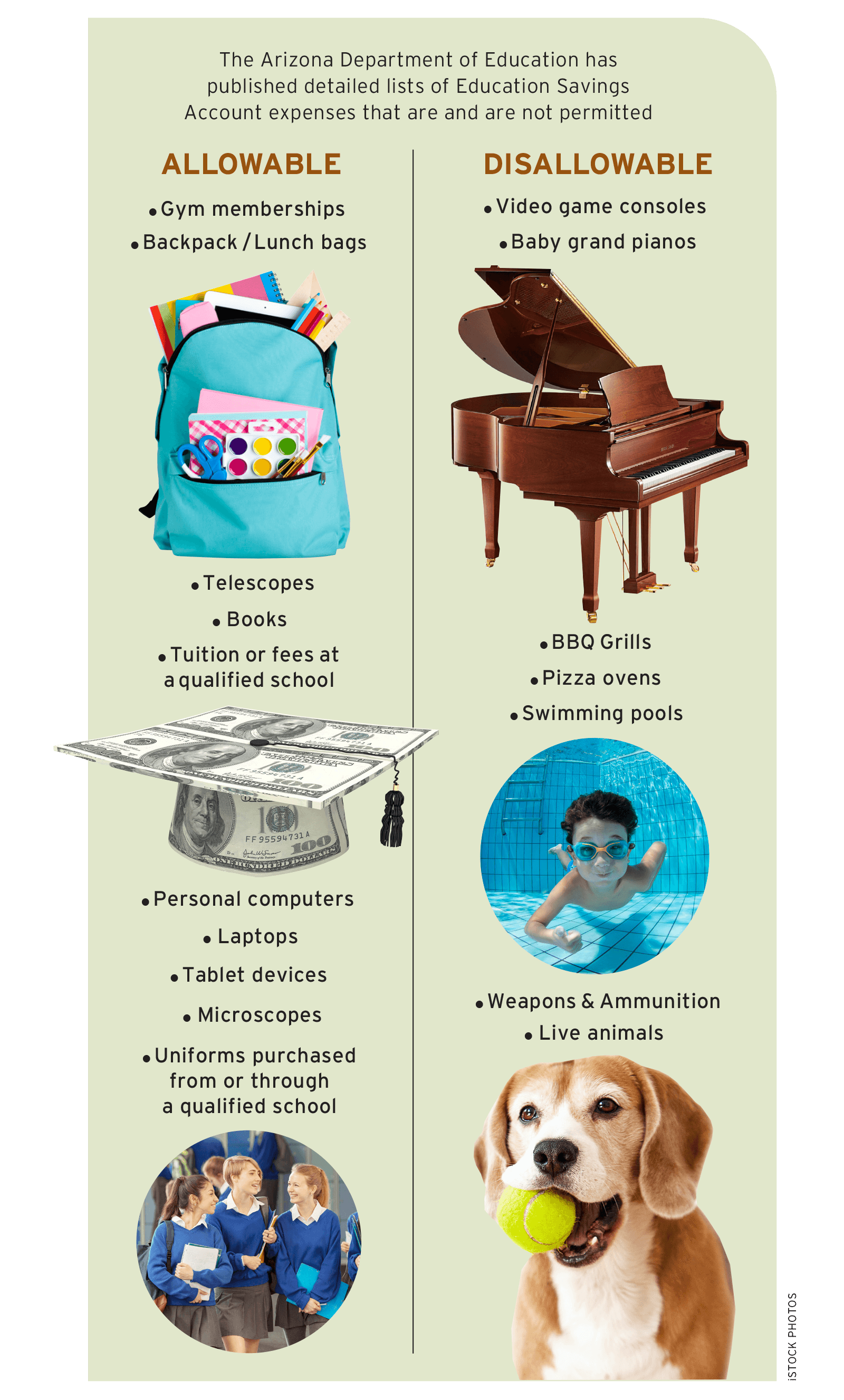
A Model—or a Cautionary Tale?
Since Accurso took office in January, the department’s rulemaking and enforcement efforts have sparked sharp criticism from both opponents who want the ESA expansion repealed and families who use and support the program.
Save Our Schools Arizona, which advocates for public schools and opposes the 2022 ESA program expansion, argues that ongoing disputes over implementing the broader program prove it has become, as the organization’s executive director, Beth Lewis, puts it, “too big to succeed.”
Lewis said that the program is “wide open” for fraud. “It is interesting to watch my taxpayer dollars be used to build a garden in everybody’s backyard, when my public school can’t afford one,” she said. “It’s just this unspoken rule of, if you see it in a public school, then it’s approvable.”
Other states should view Arizona’s move to universal eligibility not as a model but as a cautionary tale, Lewis argues. She sees evidence of that happening in states such as Arkansas and Iowa, where newly passed laws call for incremental, multiyear expansions before getting to universal eligibility.
“I think they looked at Arizona and saw that this is a complete disaster and is not serving families well,” Lewis said. “There’s no way to ensure transparency. And they said, ‘Well, at the very least, we need to phase this in.’”
School-choice advocates tend to defend Arizona and see its uneven expansion process as par for the course when states try something different to promote educational freedom.
“We’re not trying to create something that’s easy to administer,” said Heritage Foundation education policy scholar Jonathan Butcher. “We’re not doing this for the department of education; we’re doing this for the families.” Still, he added, “Arizona’s story offers a lot of dos and don’ts.”
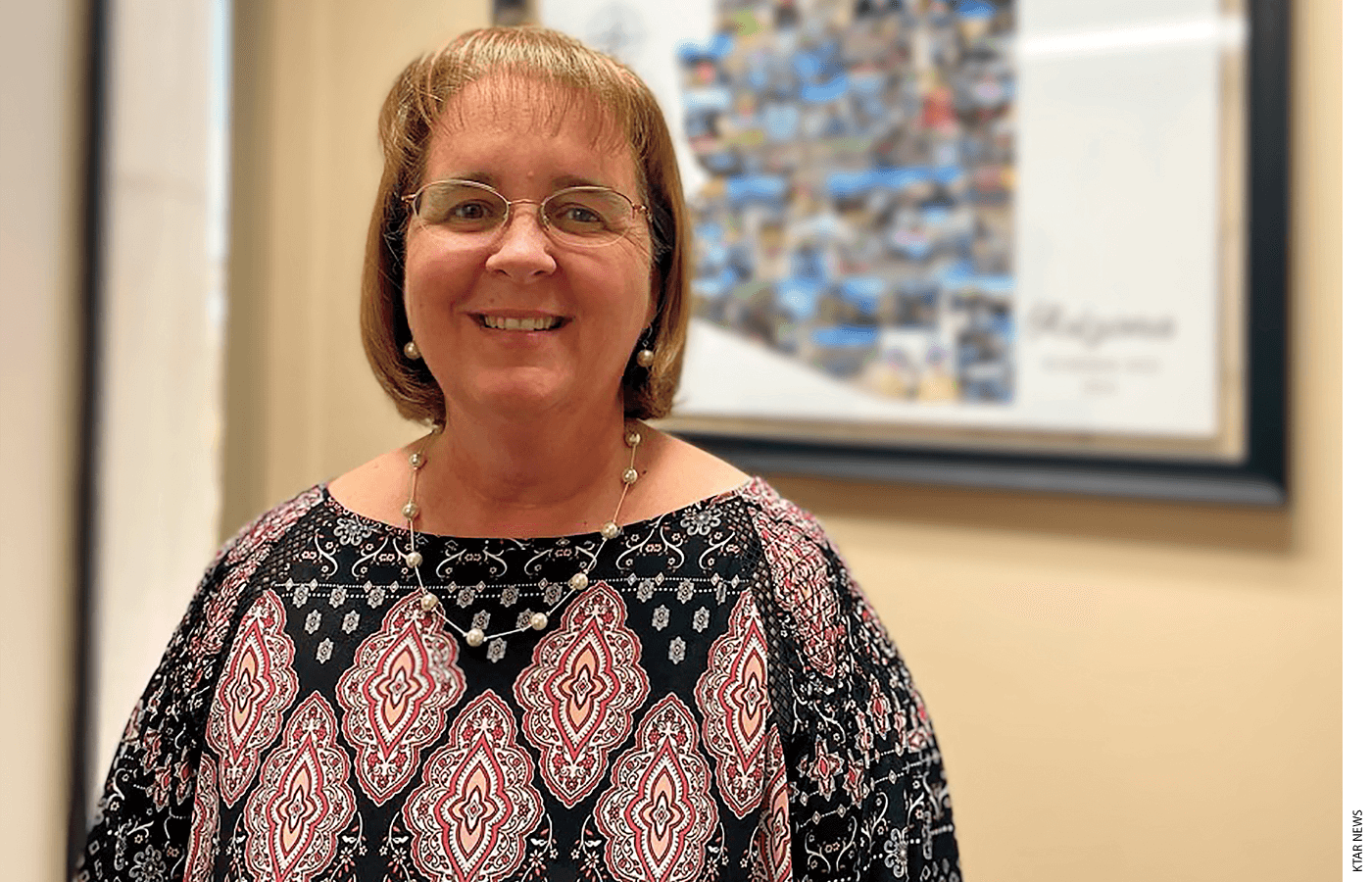
Flashpoint: Approving Expenses
Figuring out how to define allowable expenses and police ESA spending is one key challenge for which Arizona’s story may prove instructive to other states.
In 2019, Arizona contracted with the company ClassWallet to facilitate ESA transactions on its online spending-management portal. ClassWallet is also used by ESA programs in Indiana, Missouri, New Hampshire, and North Carolina.
ClassWallet stresses that its role is not to set the rules for what constitutes acceptable expenses. “We are 100 percent not the arbiter of any programmatic decisions whatsoever,” said CEO Jamie Rosenberg. “We are simply a technology that is configured by the client.”
Regarding allowable expenses, Accurso advises families that “as long as it’s typically known as an educational item, you’re going to purchase those with no problem. If there’s something that’s not typically known as an educational item, then all they have to do is send us the curriculum with the materials list on it that shows that those items are needed.”
The Arizona Department of Education is, in theory, charged with approving all purchases using ESA funds, but Accurso said she inherited a backlog of more than 170,000 unapproved expense orders, more than 50,000 of which had no receipts attached or such scanty receipts that her staff must call vendors to verify purchases item by item.
Until ClassWallet came in, families primarily accessed ESA funds through prepaid debit cards. Accurso favors halting that practice, and shortly after taking office she announced that, in the interest of curbing misspending, no new cards would be issued. Still, amid strong advocacy from parents opposed to ending debit cards, the department has allowed families who already had such cards to keep them.
“The administrative burden of a prepaid debit card is huge,” Accurso said. Minimizing misuse becomes harder “when a parent can swipe the debit card and the money is out the door with no accountability until the receipts are received.”
Such a process became untenable after the program swelled, Accurso said. A “tsunami” of new applicants hit after expansion to universal eligibility in late September 2022, she noted. The number of Arizona ESAs rose to more than 60,000 by mid-June 2023 from 13,000 the previous September, and Accurso expects another wave to hit in 2023–24.
While ClassWallet allows for debit cards, its platform was basically designed to replace them. “Among our clients, Arizona is the only client that uses our debit-card feature,” Rosenberg said. The company’s “digital wallet,” he added, offers guardrails and compliance mechanisms that a debit-card system lacks.
Parents in Arizona have more than one way to access ESA funds. They can use their ESA digital wallet to shop on ClassWallet’s online “marketplace” for products from an array of vendors, including giant retailers such as Amazon or Staples and education companies such as Scholastic or Lakeshore Learning.
Families can also directly pay vendors and education-service providers that have registered to be part of the ClassWallet portal. Such payments may go for tuition, private school expenses, tutors, paraprofessionals, school uniforms, and more. To use vendors or providers that are not on the ClassWallet portal, parents may pay out-of-pocket and then submit the receipts and any required documentation for reimbursement.
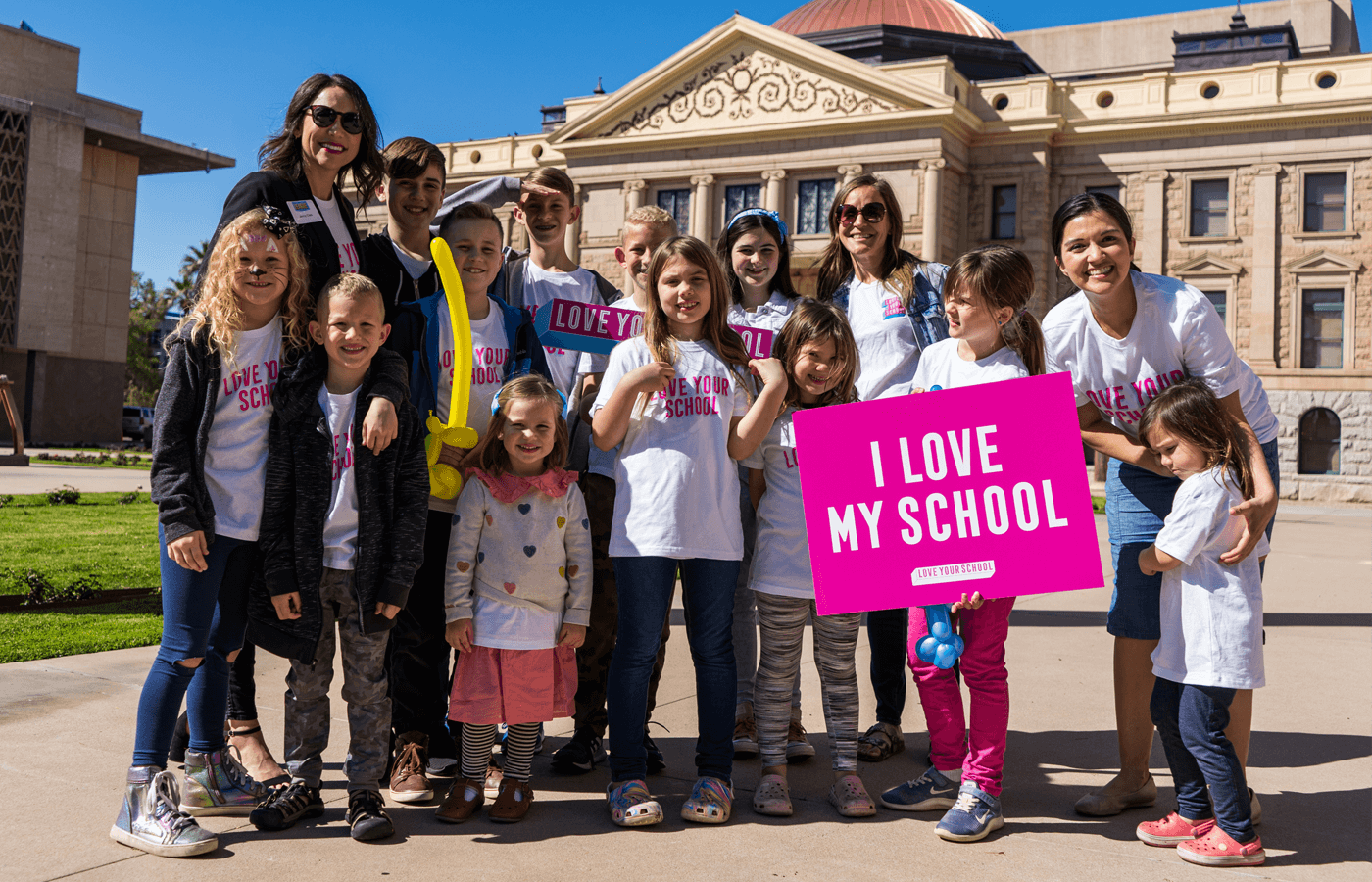
Families Want Flexibility
Some of the Arizona program’s new spending-accountability measures had been on the books before but were not enforced, Accurso said. “A lot of people who’ve been in the program for a long time are pushing back, very upset” that rules are now being applied, because parents “never had to do these things before,” she said.
Among those pushing back is Jenny Clark, the founding CEO of Love Your School, an Arizona nonprofit launched to help families navigate school options. In 2022, Clark won gubernatorial appointment to the state board of education. While fiercely supportive of the ESA program, she does see opportunity for improving the way the program is administered.
“The program is working very well for families who are utilizing those dollars for traditional school options, whether that’s a micro school or a private school—things that are pretty easy and require less transactions,” said Clark, a mother of five. “For families like myself—I have some kids in private school and then I have other kids that are home educated—we’re customizing and building out for them a very unique and curated education. That requires a lot of different purchases, and it requires a lot of flexibility with our ESA.”
After Accurso came out against issuing new debit cards, the department was flooded with email messages and state board testimony from parents who shared Clark’s view that the cards—about 16,000 of which are in circulation—are “very, very important for us to navigate the program successfully.”
Clark says it is valuable for parents to push the bounds of allowable expenses and to appeal rejections to the state board. She wants Arizona to take a broad-minded approach to what qualifies as educational and hopes other states will do the same.
“Policymakers need to understand that the utilization of these programs is going to be directly related to allowable expenses,” she said. “We don’t want to set so many barriers that we make the program difficult to use for the people that need it the most.”
Smaller, Targeted Programs
When asked which ESA programs should serve as models, national school-choice advocates tend to point to programs that are smaller and more targeted than the broad programs that are operating or being launched in states such as Arizona, Arkansas, Florida, Iowa, and Utah.
Two smaller ESA programs are those in New Hampshire, which is focused on children from low- and moderate-income families, and North Carolina, which serves children with disabilities.
Besides being targeted rather than universal, both programs are run by entities with years of experience operating other school-choice programs for their states. Neither uses prepaid debit cards. And despite growing rapidly in recent years, each serves between 3,100 and 3,300 students.
“We’re lucky in New Hampshire because our program is small,” said Kate Baker Demers, executive director of Children’s Scholarship Fund New Hampshire, which runs the state’s Education Freedom Accounts program. “My team can put human eyes on everything. It’s not unwieldy in any way.”
In North Carolina, staff at the State Education Assistance Authority, which has long disbursed financial aid for higher education, personally approve ESA expenses via the ClassWallet platform.
“If there’s been an error, it’s not on the families’ part. We are pre-approving 100 percent before it’s spent,” said Marker of the North Carolina authority. “I can’t say we will never, ever have a misuse of funds, but we’ve got a pretty tight process.”
Although New Hampshire’s Demers said that “implementers in other states are calling and asking me for advice,” she does not have easy answers for those looking to scale up a spending-management system like hers to much larger programs.
Marker agrees, but said she is nonetheless trying to prepare should lawmakers expand the program. “If North Carolina wants to do that, we will try to do it with excellence,” she said. “It’s just prudent to look at our technology, look at our staffing model. We’re watching what’s happening around the country, and we’ll try to be ready.”
Getting the Technology Right
Some school-choice advocates are heartened by growth in companies working to automate and streamline various aspects of operating ESA programs. Besides applying lessons from other school-choice mechanisms such as tax-credit scholarships, vendors are eyeing government programs in sectors including health care, food assistance, and natural-disaster aid. Some also are adopting financial technology practices used in products such as Venmo or Zelle.
“Expansive ESAs represent a new sector, and the technological demands are constantly increasing,” said Mark Duran, co-founder and CEO of Student First Technologies, which is working to build on its experience with tax-credit scholarships and microgrant programs to win more ESA contracts.
Duran said his company is trying to anticipate future needs, in part by augmenting its ESA platform with artificial-intelligence and machine-learning features to systemize and automate expense verification.
“I wouldn’t say anybody, including us, has completely figured out an ESA solution. Nobody’s doing it perfectly yet,” Duran said. “If you’ve built your tech right, you can reuse different elements, but it has to be modular in the sense that you have to be able to customize it on a state-to-state basis.”
In Florida, Tuthill learned that lesson firsthand when Step Up for Students agreed to power West Virginia’s ESA program rollout in 2022. Halted midstream by a court injunction that was ultimately lifted, implementation of the program consumed so much time that Tuthill says he’s now more cautious about customizing his platform for other states—especially in light of the big changes underway in his home state.
Tuthill says the Step Up for Students platform, Education Market Assistant (EMA), has about “20 different apps” working behind the scenes. “I’ve got artificial intelligence partners. I’ve got software development partners,” he said.
Increasing the level of automation will be vital, given the Florida program’s impending growth, as Tuthill sees it, and working out the kinks must be a priority.
“States are calling us continuously,” Tuthill said. “I have to get to the point where I can scale in Florida but also be able to cut and paste my infrastructure in Florida and use it in other states.”
ESA Pitfalls
Many supporters of school choice urge close attention to infrastructure and lessons learned in places such as Florida and Arizona. But not everyone is convinced that applying those lessons will be enough to ensure that the latest iteration of school choice won’t end up as another failed fad.
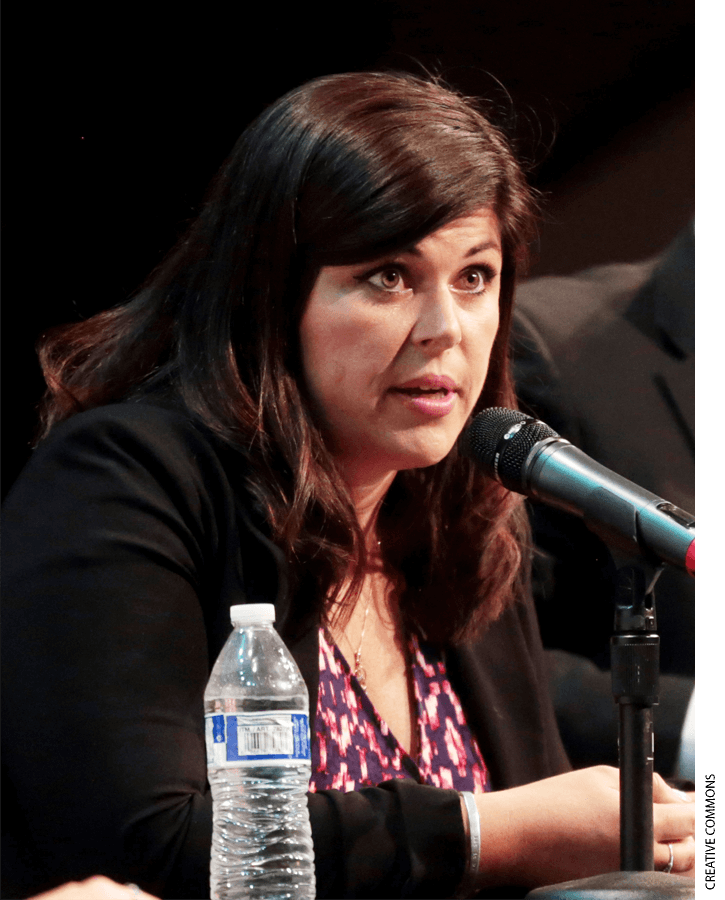
In a piece explaining why he is wary of universal education savings accounts, veteran analyst Chester E. Finn Jr. said he expects ESAs to face woes afflicting other school-choice programs. Those include parents who make dubious education decisions, shoddy startup schools, and “the education version of waste, fraud, and abuse.”
Finn, a distinguished senior fellow at the Thomas B. Fordham Institute, noted that universal ESA programs carry risks: windfalls for well-off parents who could afford to pay for private schools on their own; entrepreneurs’ setting up new schools in wealthy areas and ignoring poorer ones; “and the use of ESA dollars by parents to purchase things with, at best, a hazy relationship to K–12 education—tickets to amusement parks, trampolines, and such. It doesn’t take many such extravagances to put a cloud over the whole policy.”
Other choice supporters see such fears as overblown. Enlow of EdChoice said he gets “really frustrated” by predictions of negative publicity eroding support for ESAs.
“I keep hearing this kind of panic about a bad story,” Enlow said. “There have been bad stories in Florida, but they’ve expanded their programs. I don’t want to make policy based on someone’s worry about a bad story.”
Arizona, to be sure, has seen its share of such stories. “People are not happy,” said Lewis of Save Our Schools Arizona, which portrays ESAs as thinly disguised vouchers that divert money from underfunded public schools and invite profiteering. “They don’t like the idea of people using taxpayer dollars to buy chicken coops and trampolines and gardens and home gyms and all of this stuff that could be justified as an educational expense.”
Similarly, she questions families’ use of ESA funds for “zoo trips and bounce memberships” when “most of our public-school students only get to go on field trips every few years. It is a very cavalier statement to say public schools do it all the time, so I should get to do it.”
Jason Bedrick, a research fellow in the Heritage Foundation’s Center for Education Policy, regards comparisons to public school purchases as fair play. From theme-park tickets to backyard sports equipment, he said, “all of these things are things that public schools are buying.”
“Go to SeaWorld, and you’ll see a whole bunch of school buses out front. What do you think those school buses are from? Those are called public-school field trips. And you’ll see the same thing at other aquariums and museums and even amusement parks,” Bedrick said. “Kayaks, trampolines, you will find these in public-school athletic programs.”
What’s Ultimately at Stake
The differences that divide Lewis and Bedrick will undoubtedly persist as states move forward with their visions of ESAs for all. Policy debates over public funding for education—and how much say parents should have over how that money is spent—will remain unsettled for the foreseeable future.
It is possible, of course, that the positions on ESAs that taxpayers and their elected representatives ultimately embrace will not be determined by how well administrators carry out their tasks of turning policy into practice.
But in Florida, where Doug Tuthill is working to carry out the wishes of policymakers for a dramatic ESA expansion, that’s not how the situation feels. There, the stakes of getting implementation right couldn’t seem higher.
“For me, the holy grail is: if you can’t scale it, it’s not really going to do anything. So, the question is, can you build an infrastructure that creates a public education system that’s built around customization?” Tuthill said. “That’s really what this is about. It’s about how do we move from a one-size-fits-all, industrial model of education to a much more decentralized, customized model, but do it in a way that continues to serve the public good? It’s a fascinating, fascinating issue. But the infrastructure to scale it is really where you’re going to win or lose.”
Caroline Hendrie is an independent journalist based in Maryland.
This article appeared in the Fall 2023 issue of Education Next. Suggested citation format:
Hendrie, C. (2023). As Many More States Enact Education Savings Accounts, Implementation Challenges Abound: ESAs increase choice for families but leave administrators asking: Are pizza ovens, pianos permitted expenses? Education Next, 23(4), 8-16.


